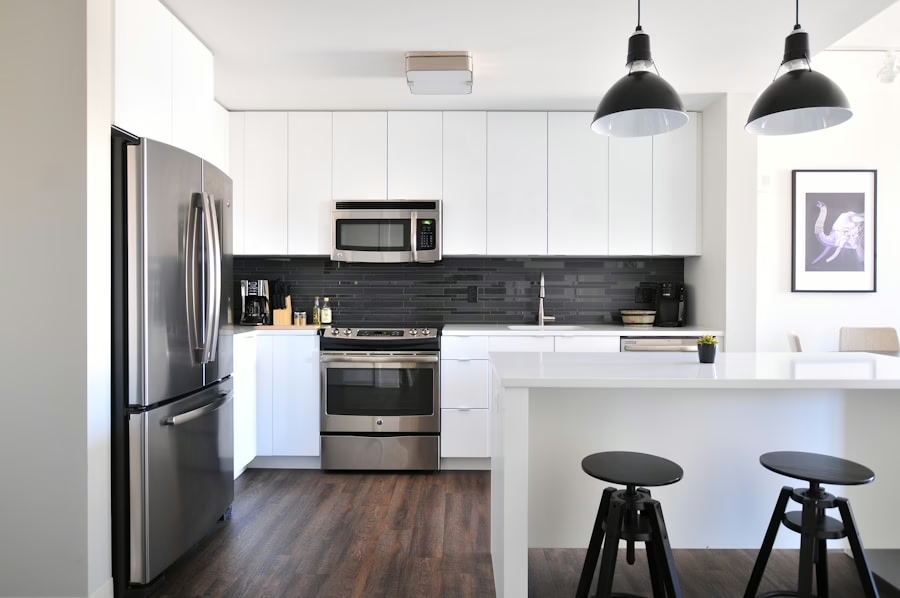Simplify Your Life: A Beginner’s Introduction to Home Automation
Key Takeaways
- Home automation simplifies daily tasks and routines by using smart technology to control and automate various aspects of your living space.
- Understanding the basics of home automation is essential for beginners to effectively introduce automation to their living space.
- Smart home technology streamlines daily routines by allowing for remote control and automation of lighting, heating, security, and entertainment systems.
- Introducing automation to your living space can enhance convenience, comfort, and efficiency in your daily life.
- Exploring the benefits of smart home technology can help you understand how automation can simplify your life and enhance your home.
Home automation is a revolutionary concept that has transformed the way we interact with our living spaces. At its core, home automation involves the use of smart devices and systems to control various aspects of your home, from lighting and temperature to security and entertainment. These interconnected devices communicate with each other and can be managed through a central hub or smartphone app, allowing homeowners to effortlessly control their environment with the touch of a button or a simple voice command.
The foundation of home automation lies in the Internet of Things (IoT), a network of physical devices embedded with electronics, software, and sensors that enable them to collect and exchange data. This technology allows for seamless integration between different smart home devices, creating a cohesive ecosystem that can be customized to suit individual needs and preferences. As the field of home automation continues to evolve, new innovations are constantly emerging, offering even more ways to simplify and enhance our daily lives.
Streamlining Your Daily Routine with Smart Home Technology
Smart home technology has the power to revolutionize your daily routine, making everyday tasks more efficient and less time-consuming. Imagine waking up to gentle, gradually brightening lights that simulate a natural sunrise, while your smart thermostat adjusts the temperature to your ideal morning setting. As you prepare for the day, your coffee maker automatically brews your favorite blend, and your smart speaker provides you with weather updates and traffic information for your commute.
Throughout the day, your home continues to work for you, even when you’re away. Smart doorbells and security cameras allow you to monitor your property remotely, while automated blinds adjust to optimize natural light and energy efficiency. Upon returning home, your smart lock recognizes your approach and unlocks the door, while your favorite playlist begins to play through your whole-home audio system.
These seamless integrations not only save time and energy but also create a more comfortable and personalized living environment.
Introducing Automation to Your Living Space
When it comes to introducing automation to your living space, it’s essential to start with a clear vision of what you hope to achieve. Consider the areas of your home that could benefit most from smart technology, such as lighting, climate control, or security. Begin by selecting a few key devices that address your primary needs and gradually expand your system as you become more comfortable with the technology.
One popular starting point is smart lighting, which can be easily integrated into existing fixtures and controlled through voice commands or smartphone apps. Another common entry point is a smart thermostat, which can learn your temperature preferences and adjust accordingly, potentially saving energy and reducing utility costs. As you become more familiar with these initial devices, you can explore more advanced options like smart locks, cameras, and whole-home audio systems to further enhance your living space.
For more information on home automation, visit Vesternet.
Simplifying Your Life with Home Automation
Home automation has the potential to significantly simplify various aspects of daily life, freeing up time and mental energy for more important pursuits. By automating routine tasks and creating customized schedules, you can reduce the cognitive load associated with managing your home environment. For example, setting up automated routines for morning and evening can ensure that your home is always prepared for your arrival or departure, without requiring constant manual adjustments.
Moreover, home automation can help streamline household management by providing valuable insights into energy usage, security status, and maintenance needs. Smart energy monitors can track your power consumption and suggest ways to optimize efficiency, while connected appliances can alert you to potential issues before they become major problems. By leveraging these technologies, you can proactively address household concerns and maintain a more organized, efficient living space with minimal effort.
Exploring the Benefits of Smart Home Technology
The benefits of smart home technology extend far beyond mere convenience. One of the most significant advantages is increased energy efficiency, which can lead to substantial cost savings over time. Smart thermostats, lighting systems, and appliances can automatically adjust their operation based on occupancy, time of day, and even weather conditions, ensuring that energy is not wasted when it’s not needed.
Another key benefit of home automation is enhanced security. Smart security systems can provide real-time monitoring and alerts, allowing homeowners to keep a watchful eye on their property from anywhere in the world. Features like automated lighting schedules and smart locks can create the illusion of occupancy when you’re away, deterring potential intruders.
Additionally, smart smoke detectors and water leak sensors can provide early warning of potential hazards, potentially preventing costly damage and ensuring the safety of your home and loved ones.
Getting Started with Home Automation
To get started with home automation, it’s important to assess your specific needs and priorities. Begin by identifying the areas of your home that would benefit most from automation, such as lighting, climate control, or security. Research different smart home ecosystems and platforms to find one that aligns with your goals and budget.
Popular options include Amazon Alexa, Google Home, and Apple HomeKit, each offering a range of compatible devices and features. Once you’ve chosen a platform, start with a few key devices that address your primary concerns. This might include smart bulbs, a smart thermostat, or a video doorbell.
As you become more comfortable with the technology, gradually expand your system by adding new devices and exploring more advanced features. Remember to prioritize compatibility when selecting new devices to ensure seamless integration with your existing setup. With patience and experimentation, you’ll soon discover the perfect combination of smart home technologies to simplify and enhance your daily life.
Enhancing Your Home with Automation Technology
As you become more familiar with home automation, you’ll discover countless ways to enhance your living space and daily routines. Consider incorporating smart appliances into your kitchen, such as refrigerators that can track inventory and suggest recipes based on available ingredients, or ovens that can be preheated remotely. In the bathroom, smart mirrors can display weather forecasts, news updates, and even personalized skincare recommendations while you prepare for the day.
For entertainment enthusiasts, whole-home audio systems and smart TVs can create immersive experiences throughout your living space. Voice-controlled assistants can help manage your media, adjust lighting and temperature, and even order groceries or other household supplies.
As you continue to explore the possibilities of home automation, you’ll find that the potential for customization and enhancement is virtually limitless, allowing you to create a truly personalized and efficient living environment that caters to your unique needs and preferences.
FAQs
What is home automation?
Home automation refers to the use of technology to control and automate household systems and appliances. This can include lighting, heating, air conditioning, security cameras, and more.
How does home automation work?
Home automation systems typically involve the use of smart devices, such as sensors, cameras, and smart speakers, that are connected to a central hub or control panel. Users can then control and automate these devices through a smartphone app or voice commands.
What are the benefits of home automation?
Some of the benefits of home automation include increased convenience, energy efficiency, improved home security, and the ability to customize and personalize your living space to better suit your needs and preferences.
What are some common examples of home automation devices?
Common examples of home automation devices include smart thermostats, smart lighting systems, smart locks, smart security cameras, smart speakers, and smart appliances such as refrigerators and ovens.
How can I get started with home automation?
To get started with home automation, you can begin by researching and purchasing individual smart devices that suit your needs, or invest in a comprehensive home automation system that includes a central hub and multiple compatible devices.
Is home automation secure?
Home automation systems can be secure if proper measures are taken, such as using strong, unique passwords for your devices and network, keeping software and firmware updated, and using secure, encrypted connections for remote access.
Can I install home automation devices myself?
Many home automation devices are designed to be easily installed by the average homeowner, with no professional installation required. However, some more complex systems or devices may require professional installation.



